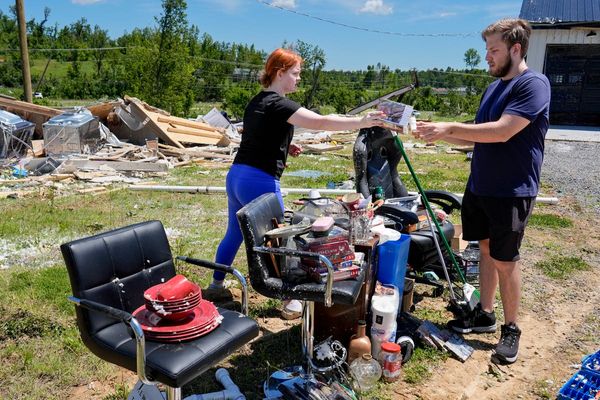
There are masquerade traditions all around the world. Bulgaria has the Babugeri, men who dress in full-body animal costumes and perform rituals intended to banish evil spirits. Babugeri can be seen at the Surova folk feast that takes place in the Pernik region. My work is not to photograph the masquerade. My work is to photograph the figures, almost like sculptures. So I make appointments with these men and travel out to photograph them in their own landscape, on their own territory. You get to a field and these guys are dressing up next to their cars, and then they come and stand in front of you. It’s a powerful moment when you are facing them. That’s the moment I like.
This costume is made of goat fur. The quantity of fur needed to make one costume is crazy – I think it’s eight goats. You have to be a young and fit man to wear them because they’re very heavy. I once photographed a guy who was not just dressing up but also breeding the goats and killing them himself. He was invested in the whole process, because these costumes are not cheap at all.
This image is from my project Wilder Mann. I have many photographs of different masquerade traditions all over the world. I’ve just returned from the centre of Borneo, where they make costumes not with fur but with grass and banana leaves, mixed with anything they find from the forest. Different materials but the same system. Sometimes there are extra layers to a costume – old clothes, fabrics – which make it more complex, like a collage. You have these traditions in Britain, too, with characters like Jack in the Green in England, or The Burryman in Scotland. But whether it’s a green man or a guy dressed in fur, you get the same feeling – of facing something from nature.
For the first two years of this project, I was OK with people saying, “Oh, this is paganism,” and telling me it’s a really ancient tradition that comes from the middle ages or neolithic times. But the origins of these traditions are actually not very precise and they have all been adapted over time. They constantly change. More recently they’ve been influenced by media, technology, cinema, Facebook, whatever. And they have influenced cinema in return. Star Wars’s Chewbacca, for instance, was inspired by folk traditions in Europe.
This image is very simple. It’s a photograph that can’t be shot in any other way. My work has nothing complex in it, but I never work quickly. A shoot like this takes 45 minutes to an hour to get the image right. Sometimes you see the eye of the guy, or the hands like in this one – there is always something you can’t control.
A lot of these rituals are connected to the Christian calendar. For example, the Penitensya in the Philippines, where people whip themselves, happens around Easter. Some rituals are on or around Christmas day, others at the new year. In the UK, the traditions are usually during spring and summer.
It is obvious this costume is phallic – a lot of these traditions are associated with fertility. There is also a Greek tradition called Arapides, where the guys dance in a circle dressed a bit like this, with very tall costumes made from animals. You have to be a teenager or a young man: no children and no women are allowed in the circle. The rules are very strict and you always want to know why. Because at the end of the day, what is this? In Bulgaria, it’s a group of guys who are going to spend three days jumping around and dancing, drinking too much alcohol and posing for selfies to post on social media. I think the combination of wearing the costume and the lack of oxygen inside, plus the alcohol consumed, can make people believe they are a real animal.
Charles Fréger’s CV

Born: Bourges, France, 1975
Trained: “I am the son of a farmer so originally I learned agriculture, then went to fine art school in Rouen, Normandy”
Influences: “Painters more than photographers: Flemish primitive artists such as Jan van Eyck; the light of Vermeer; Spanish artists like Diego Velázquez”
High point: “The first time I photographed a sumo wrestler in his circle in 2002. That’s when I realised my work was about getting into someone else’s space”
Low point: “Sometimes feeling that I am not really a part of the world as it is now”
Top tip: “Stay in the reality”
• This image is part of Human.Kind, a group exhibition at the International Red Cross and Red Crescent Museum in Geneva until 14 April, in collaboration with Prix Pictet.







